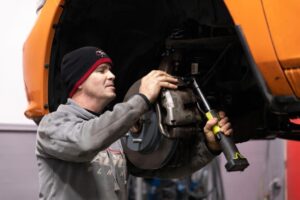
DIY Car Body Repair: A 2024 Guide
DIY body repairs are becoming increasingly popular in 2024 as car owners look for cost-effective and satisfying ways to maintain and improve their cars. The beauty of DIY repairs isn’t just the cost savings, it’s the personal achievement of fixing your car. This guide delves into the essentials of DIY body repair and provides insights, techniques and tips to help enthusiasts solve common repair problems with confidence.
1. Understand body damage
Body damage can range from minor dents and scratches to major structural problems. Common causes are accidents, weather influences and daily wear and tear. Identifying the type of damage is critical to determining the correct repair method.
2. Essential tools for DIY body repair
It’s essential to start with a basic tool kit, including items like a hammer, dolly set, sander, and filler. More complex repairs may require advanced tools such as pneumatic dent pullers and paint sprayers. Investing in quality tools will pay off in the long run.
3. Prepare for repair
Before you begin any repair work, it is crucial that you properly assess the damage. Thoroughly cleaning the affected area will ensure that the damage is clearly visible and will remove any debris that could disrupt the repair process.
4. DIY repair techniques
Techniques vary depending on the type of damage. Minor dents can often be repaired with simple methods such as a suction cup puller, while scratches may require sanding and filling. In case of major damage, it may be necessary to process the panels and use filler.
5. Painting and finishing
Surface preparation is the key to successful painting. By choosing the right paint and applying it correctly, you can get a finish that matches the rest of your car. The final step involves polishing and sealing to protect the restoration.
6. Avoid common mistakes
Common pitfalls of DIY auto body repair include lack of preparation, using the wrong tools, and rushing the process. Attention to detail and patience are crucial to avoiding these mistakes.
When should you seek professional help?
DIY repairs have their limitations. Recognizing when repairs are beyond one’s skill level is important to prevent further damage. If damage is severe or specialized equipment is required, professional assistance may be required.
7. Maintenance tips to prevent future damage
Regular maintenance and proactive conservation measures can significantly reduce the chance of future damage. This includes regular cleaning, waxing and parking in a cool place to prevent environmental damage.
Cost-benefit analysis of DIY versus handmade professional repair
Although DIY repairs can be cost-effective, it is important to consider the time investment and skill level required. In some cases, professional repairs can be more economical and reliable.
8. Learning resources and tutorials
There are plenty of resources available for people looking to improve their DIY repair skills. Online tutorials, books and local workshops provide valuable guidance and practical experience.
9. Legal and security considerations
When it comes to DIY auto body repair, it is crucial to understand the legal requirements and safety measures. It is essential that repairs meet road safety standards and that precautions are taken to prevent personal injury.
10. The environmental impact of DIY body repairs
Using environmentally friendly repair methods, such as using water-based paint and properly disposing of waste materials, can minimize the environmental impact of DIY repairs.
11. The future of DIY body repair
Technological developments such as 3D printing will revolutionize DIY car repair. Keeping up with these trends can provide DIY enthusiasts with new opportunities and approaches.
Conclusion
DIY body repair in 2024 offers a rewarding and practical way to maintain and improve your vehicle. With the right tools, techniques and knowledge, hobbyists can achieve professional-quality results while saving money and enjoying the satisfaction of a job well done.
FAQs
1. What are the most common types of bodywork damage?
The most common types are dents, scratches and paint chips, often caused by minor blemishes or daily wear and tear.
2. Can I carry out all types of car damage repairs at home?
While many minor repairs can be done at home, repairs that involve major damage or require specialized equipment are best done by professionals.
3. What should I consider before attempting a DIY body repair?
Consider the extent of the damage, your skill level, the tools required, and the time investment required to ensure a successful repair.
4. How to learn DIY body repair techniques?
Use online resources, attend workshops, read repair manuals and practice on old car panels to develop your skills and confidence.
5. Are there eco-friendly options for DIY body repair?
Yes, using water-based paint, ensuring proper waste disposal and minimizing the use of hazardous materials can make your repairs more environmentally friendly.



